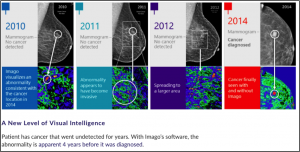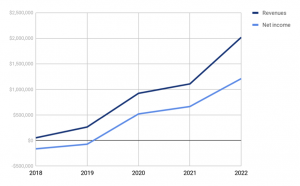Opportunity
Mammography, the first line of defense in detecting breast cancer, is a high-volume area of medical practice: roughly 39 million mammograms are conducted in the US alone annually.[1] Mammograms are performed using a low-dose x-ray machine that sends ionizing radiation through the body structure. The product is the black and white x-ray image with which most patients are familiar. While medical X-ray technology as a whole underwent digitization at the turn of the 21st century, the newly digitized visual output remained black and white, simply a high-resolution version of the familiar image on which thousands of medical practitioners had been trained. Thus the medical science of reading a diagnostic mammogram remained essentially unchanged.
We believe this digitization without transformation was a dramatic missed opportunity. First, while digitized diagnostic x-rays do capture a rich range of grayscale (anywhere from over 4,000 to nearly 66,000 shades, or 12-16 bits/pixel), their usefulness is constrained by the number of gray shades a computer monitor can display (most of which have caught up to current imaging machines, but which still remain a funnel point as diagnostic machinery improves).[2] Second, and more importantly, the human eye can only distinguish approximately 30 of these many thousands of shades of gray.[3] Thus, even the highest-trained radiologists have a naturally limited capacity to distinguish normal and abnormal structures within the breast when represented in grayscale.
A commonly used tool today is Computer-Aided Detection (CAD), which reviews the digital x-ray, searches it for abnormal areas of density, and displays a visual marker (such as a yellow triangle or red square) near these places for the radiologists to carefully visually review. CAD encourages more careful image review by the radiologist, and its use resulted in a 6% increase in early detection over non-CAD image reads.[4] Yet CAD does little to address the difficulty of reading the x-ray in the first place, particularly as relates to the 40% of women with dense breast tissue. It fails to apply the fullness of computational power to analyzing the x-ray.
Consumers (both patients and radiologists) have a clear interest in reducing the instances in which an x-ray because it provides insufficient information due to lack of visual clarity, necessitates additional diagnostic imaging. Both parties also have an interest in reducing false negatives (times when cancers are present but visually undetectable within the x-ray) as well as false positives (When normal structures or non-cancerous growths are detected yet cannot be distinguished from cancerous growths). All of these contribute to increased health costs, pressures on patient mental health, and burdens on time and talent within the medical practice. The challenge is even greater in countries like India, where only about 10,000 trained radiologists exist, woefully undeserving a nation of 1.2 billion.[5]
Solution
Our company, Radiotek, will apply a smart algorithm to grayscale x-rays, analyzing groupings of pixels that relate to one another in grayscale intensity to apply distinct color sets to the previously undetectable groupings. We would apply supervised machine learning techniques and utilize training data from thousands of patients. Along with the images/scans from these patients, we would also need the outcomes. The quality of our technology would vary depending on the data on outcomes that we can collect, ranging from biopsy results to a much simpler scale for categorization of outcomes.
Our concept hopes to make a leap forward in breast cancer detection by building beyond the static algorithmic approach to bring the power of deep neural networks to abnormality detection in medical imaging. We aim to utilize convolutional neural networks for image processing in order to allow for filter-based detection of interesting features in mammograms. The end result for the clinician is a conversion from grayscale to color in an analytical manner, not merely one-to-one, revealing structures and their relationships to one another in ways the grayscale previously obscured. [6]
Fig. 1 – A high level view of convolutional neural network architecture used in face detection
The end goal is to produce a tool that will support the radiologist in speedy decisions, and perhaps even provide preliminary diagnostics in cases of extremely high confidence. We would also need to ensure that the algorithm is capable of reinforcement learning, in order to get feedback, learn from mistakes and ultimately move towards goals set by the radiologist or hospital in order to provide the most efficient assistance.
Empirical Demonstration
There are a number of competitors in the US, among which one, called Imago Systems, has demonstrated early success with the static version of this algorithm. Their patent-pending Image Characterization Engine (or ICE) has already launched clinical trials and is currently in the FDA review process. Below is a depiction of the ICE at work on a breast cancer case: [7]
Fig. 2- Imago Solution Implementation7
With confidence in the potential of a static algorithm, we can begin building the deep neural network. With insights from experts in diagnostics and from our research of the Indian market, we believe that in order to penetrate the market we would need to partner up with large private hospitals or research institutions in Tier I or Tier II Indian cities. Due to a more robust infrastructure and their interest in specialization, we plan to readily obtain historical de-identified clinical data on patients confirmed with or without cancers, calcifications, and other abnormalities. A partnership with these organizations will also provide a natural entry point into the market for building proof of concept.
Another competitor, Zebra Medical Vision, has tested their machine learning based algorithm and has gotten 91% sensitivity and 80% specificity – as good a performance as any published results for radiologists working with or without computer-aided detection (CAD).[8] Additionally, artificial neural networks are already in use in other diagnostic areas.[9] Given their established presence in the medical arena, we believe the time to functionality should be reasonable. Upon achieving this, we envision giving the radiologist a front-end device such as an iPad which will run the Radiotek API. The API will be communicating with multiple AWS servers (which can respond to API, run model etc.). This will ensure low initial costs for us as well as a seamless experience for the user.
Commercial promise
Both the Indian market for healthcare in general, as well as the market for radiology have been experiencing around 15-20% CAGR in recent years and are projected to continue at the same rate. The current market size of radiology is estimated at ~$1.2 bn, with high concentration in major metropolitan areas.[10] There are a number of unique benefits for Radiotek here:
- High growth sectors: Medical infrastructure market growing at 15%. Hospital services market currently valued at $80 billion and accounts for 71% of the industry revenues. Steady population growth and increasing insurance coverage. [11]
- Business-Friendly government: Low customs duty rates on medical service (9-15%) Government of India has permitted 100% FDI for all health-related services under the automatic route.
- First-mover advantage: Machine learning based diagnostics market not as competitive, and ability to capture unique market. In addition, our business model has a stronger customer stickiness element with higher switching costs for our customers.
Fig. 3- Indian radiology market geographic breakdown10
Ultimately our product would be sold under a license in which a medical center would pay for access to the algorithm, would house and store the image output within its own data centers (to conform with user privacy regulations), and would receive regular updates as the program continues to learn and improve. Users would pay the initial installation and licensing fee, then would pay monthly fees for both updates and volume usage. We would incentivize high volume usage to increase the volume of cancer detection data informing our system, and thus would provide tiered discounts to high volume users. Moreover, our product would initially be a diagnostic tool that would be validated by radiologists for every scan, but as we scale, we would allow for the tool to clear healthy patients with a high confidence level, therefore allowing other medical personnel such as nurses or technologists to read the scans and make decisions on non-complicated results. This would be truly disruptive in changing the landscape of the Indian radiology market and making it more accessible.
Financials
Lower wages in the Indian market will alleviate our labor expenses. We expect to hire two well-experienced data scientists, who would be able handle the development of the algorithm, a sales representative to be able to initiate engagements with potential customers and management at a total of labor wages of $150,000 in the first year. In addition, we expect to incur storage and computing costs through AWS EC2 at a total of ~$5500 in the first year, $20,000 for market research (industry dynamics and sales process in India), and $10,000 for misc expenses (computers, travel etc.)
| Year 1 | Year 2 | Year 3 | |
| Revenue | $54,000 | $282,000 | $1,002,000 |
| Operating costs | $156,000 | $315,820 | $365,700 |
| SG&A | $14,500 | $20,000 | $25,000 |
| Other costs | $29,500 | $20,000 | $30,000 |
| Total Cost | $200,000 | $355,000 | $420,700 |
| EBITDA | -$146,000 | -$73,820 | $581,300 |
If we are able to secure our ask of $200k we expect to be able to cover our expenses in the first year and be able to apply for a $100k loan at an interest rate of 8% that will be covering our expenses in the second year. We will then be able to produce sufficient sales beyond that with 3 license sales in our first year, 15 in our second year and 50 in our third year (break-even point) at a $12,000 installation fee and $500 usage fee per month for each license.
Fig. 4- five-year revenues & net income projections
Challenges
-
- Regulatory challenges: Murky regulatory landscape with bodies such as Indian Medical Association and Ministry of Health and Family Welfare (MOHFW). Less stringent but also less clear cut than U.S. FDA.
-
- Competition: International competitors like Imago and Deepmind as well as Indian home-grown startups such as Niramai. But different approaches/shortcomings like static algorithm, less focus on building neural network, and alternative approach to invasive radio scans, respectively.
-
- Data volume: Needing sufficient clinical data. Could work with de-identified historical data and relevant health information to provide full picture of cancer screening.
-
- Data storage: Need to find secure way of storing patient data, need to be careful about sharing data between hospital networks. Upon talking to data scientists, suggested ‘secure enclave’ on hospital servers housing data within which neural network can be trained and then removed, leaving data inside.
Sources
- JoNel Aleccia, High tech mammogram tool doesn’t boost detection, study shows (Seattle Times, September 28, 2015) https://www.seattletimes.com/seattle-news/health/high-tech-mammogram-tool-doesnt-boost-cancer-detection-study-shows/
- Tom Kimpe & Tom Tuytschaever, Increasing the number of gray shades in medical display systems — how much is enough? (J Digit Imaging, 2007). https://www.ncbi.nlm.nih.gov/pmc/articles/PMC3043920/
- Francie Diep, Humans can only distinguish between about 30 shades of gray, (Popular Science Online, February 19, 2015) https://www.popsci.com/humans-can-only-distinguish-between-about-30-shades-gray?dom=tw&src=SOC
- BreastCancer.org, Computer aided detection mammograms finds cancers earlier but increases risk of false positives. http://www.breastcancer.org/research-news/20130425-4
- Dr. Arjun Kalyanpur, The Teleradiology Opportunity in India. https://www.entrepreneur.com/article/280262
- Lawrence, Steve et. al., Face Recognition: A Convolutional Neural Network Approach. (IEEE Transactions on Neural Network, 1997) http://www.cs.cmu.edu/~bhiksha/courses/deeplearning/Fall.2016/pdfs/Lawrence_et_al.pdf
- Imago Systems website, http://imagosystems.com/
- Ridley, Erik. AI Algorithm uses color to better detect breast cancer, 2018.
- Artificial neural networks in medical diagnosis, Journal of Applied Biomedicine, 2013. https://www.researchgate.net/profile/Eladia_Pena-Mendez/publication/250310836_Artificial_neural_networks_in_medical_diagnosis/links/5698d76608aea2d743771eef/Artificial-neural-networks-in-medical-diagnosis.pdf
- Redseer Consulting, 2018: http://redseer.com/articles/indian-diagnostic-market-shifting-to-preventive-care/
- U.S. Government Export Website, Indian healthcare Industry: https://www.export.gov/article?id=India-Healthcare-and-Medical-Equipment
Team Members:
Mohammed Alrabiah
Tuneer De
Mikhail Uvarov
Colin Ambler
Lindsay Hanson




